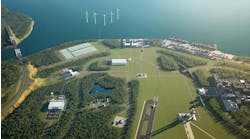Emerson Process Management has traditionally been the most reluctant of the mainstream process automation vendors to get involved in the murky world of MES. Perhaps because of its strength in instrumentation, the focus has always been on the plant floor to the extent that it could be argued that the primary job of PlantWeb, DeltaV and, latterly, DeltaV SIS has been to sell valves and instruments. Even as recently as 2006, which saw the launch of Invensys’ InFusion, key Emerson strategists were, we understand, still debating whether there was a need or indeed even a role for such an offering or whether SAP and Oracle could be safely left to populate the space between the transactional and the real-time worlds.
That the debate finally came down in favor of the development of an in-house offering is confirmed by the announcement at ARC’s Orlando forum of the Syncade Smart Operations Management suite, which is being positioned as an extension of the PlantWeb architecture into and arguably across the MES space. At the same time, however, it is being carefully differentiated from other vendors’ previous MES offerings. Indeed the press release announcing Syncade to the wider world specifically describes it as “an innovative replacement for the traditional client-server, program-intense MES software of the past decade,” which it contrasts with Syncade’s use of “the modular, scalable, Microsoft.NET framework-based software to deliver ISA95 Level 3 standards-based functionality.”
Clearly the message is that this is not MES. “Unveiling of the Syncade suite is another exciting step in realizing the fully intelligent digital plant,” is how process systems and solutions division president Tom Snead put it. “The new operations management suite integrates the industry’s broadest, most reliable process intelligence from PlantWeb architecture and makes it easy and efficient to use for optimum operational decisions.”
If all that actually sounds a lot like InFusion, then that’s probably because it looks quite a lot like it too, to judge by the graphics which accompanied the release, one of which shows four families of modules apparently plugging into a common platform. That platform is, presumably, in effect .NET, with the four families addressing the four functional areas of resource management, operations optimization, integrated information, and quality and compliance. However, in what looks like a dig at InFusion, Emerson says that, with Syncade, it is not necessary to design and implement an entire infrastructure; rather it suggests that a user’s personnel can work in conjunction with Emerson’s own people to prioritize improvement projects and then choose the appropriate modules with which to implement them. Individual modules, it claims, can support a small number of users initially, with new users being added at a later date as needed and additional modules implemented as time and budget permit.
Integration
While many of the individual modules are providing relatively conventional MES functionality, it’s those in the Integrated Information category which provide the key integration both vertically with the enterprise layer and horizontally with other systems. “Integrating smart, real-time, plant-floor data with your business practices helps your organization work smarter,” says the release. “By coordinating ‘handshaking’ functions between existing plant systems and electronically guiding manual processes, plant operations can be streamlined. Syncade suite takes advantage of industry standards to enable easy and maintainable ‘plug and play’ integration with other systems that impact your operations performance.”
Whether one regards Syncade as a belated response to other vendors’ offerings in the MES space or as a brave attempt to leapfrog the current generation in a manner not dissimilar to the development of DeltaV more than a decade ago, what is clear that is that it marks a major shift in emphasis for Emerson, as it looks upward to the enterprise layer while no doubt attempting to maintain its grip on the plant floor. The extent to which it succeeds will depend as much on the degree to which it fulfils the promise of ease of integration with third parties as it will on the quality of the individual modules.
Still Watching the Wireless Ball
Lest we might think that Syncade had taken Emerson’s eye off the wireless ball, it also used Orlando to reveal new data on the suitability of wireless for greenfield projects. JDI Contracts used Smart wireless along with wired HART and Foundation fieldbus on a new process plant for a major U.S. chemical manufacturer. Wireless was used for non-safety, low-speed control and monitoring, in all about 25% of the total points. Overall plant engineering, construction and start-up savings were found to be about 10% of the considered costs of the equivalent wired HART solution. For the bus installation, wireless savings were on a par with wired busing. The study also pointed to unquantified, but significant benefits in terms of flexibility and schedule impact.
The JDI findings were broadly in line with data derived by Emerson itself from a near-6000-point greenfield hydrotreater project. In that case wireless was applied to 44% of all points and showed significant savings of 36% in automation and installation compared with a completely wired HART solution. Foundation fieldbus was slightly less expensive than WirelessHART because of the use of high-density temperature measurement. “Our takeaway from these studies is that all three technologies — HART, Foundation fieldbus and wireless — should be in the design toolbox for capital projects,” said Emerson Process Management chief strategic officer Peter Zornio. “The studies confirm that Foundation fieldbus continues to offer the lowest cost installation for process control points. For monitoring points, both Foundation fieldbus and wireless offer good alternatives and similar installation savings. However, over the plant life cycle, wireless adds significant benefits with simplified training, flexibility and allows very easy and lowest cost incremental expansion.”
The ability of Smart Wireless to perform in difficult environments was demonstrated by a recent installation at E.ON U.K.’s 1940-MW power station at Kingsnorth in southeast England. A total of 14 Rosemount wireless transmitters have been installed to provide access to flow percentage readings from new non-intrusive ultrasonic flow meters monitoring treated water usage. Despite the presence of large turbines, piping and metal walkways in the 500-m long turbine hall, the transmitters took around two hours to configure and less than six hours to install, whereas a wired solution would have taken one to two weeks to complete. Flow measurement data is transmitted every 15 seconds to an Emerson Smart Wireless Gateway, situated in the main administration building on the other side of the road from the turbine hall. The data is then passed over Ethernet to Emerson’s AMS Suite, which manages the wireless transmitters and uses its OPC server to export the flow data to the plant’s PI data historian.
Emerson Financials
Despite the parent company seeing sales decline 2% and net earnings by 15% in the quarter ended December 31, 2008, Emerson Process Management was able to buck the trend by posting sales growth of 8%, which translates to 14% when the effects of currency fluctuations are ignored. Sales growth in the U.S. was 10% and 16% internationally while the sector margin widened further to 19.4%.



